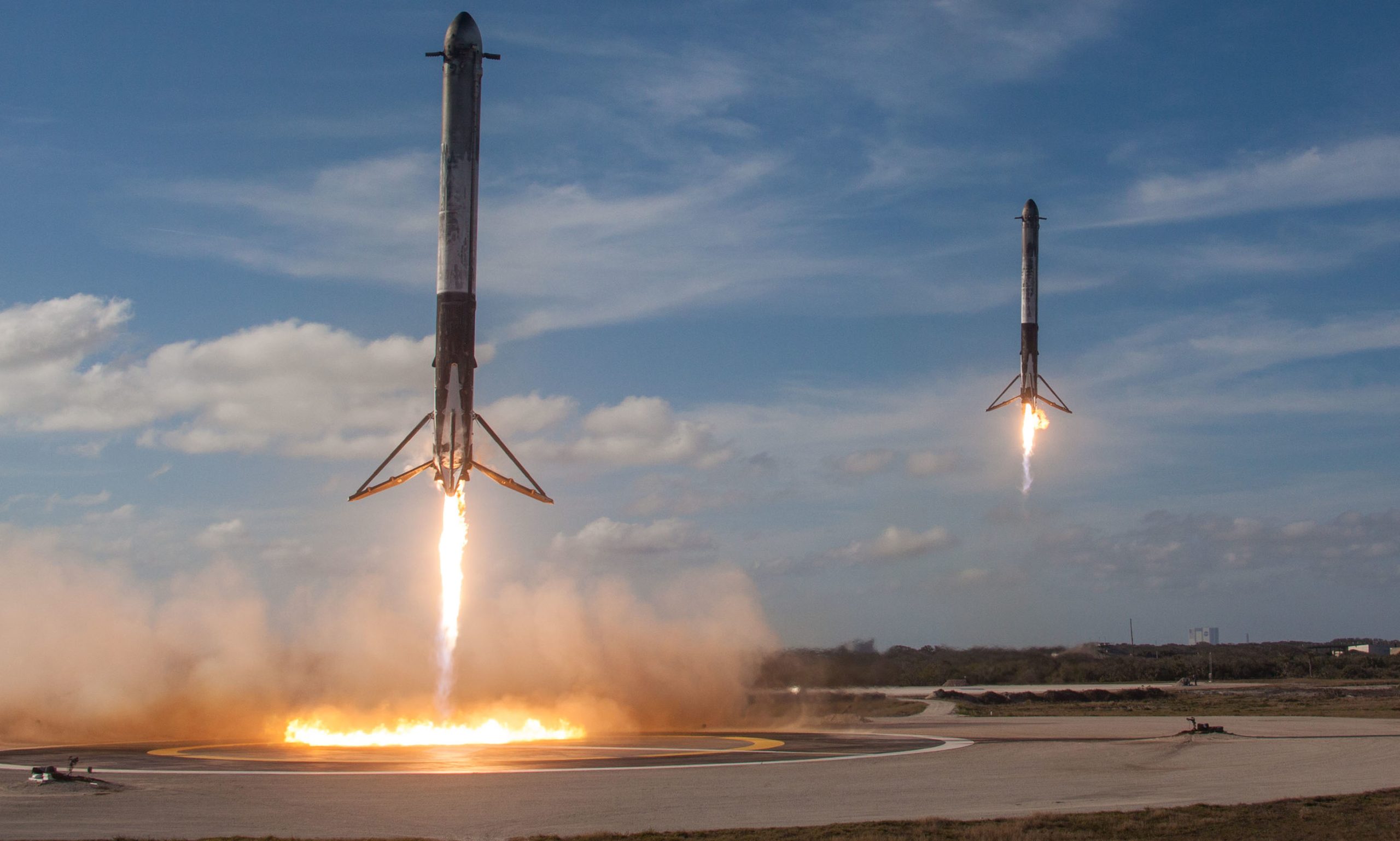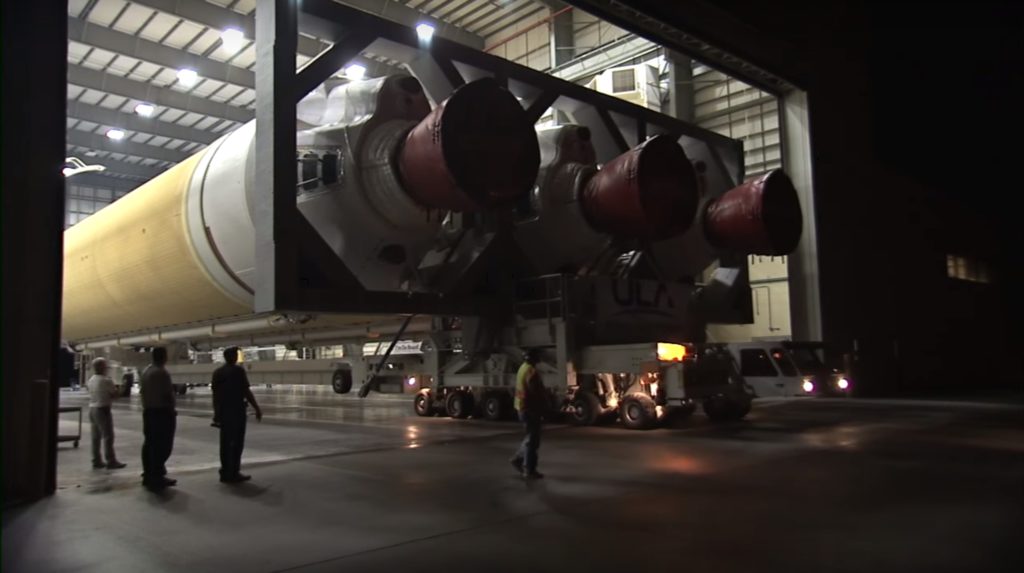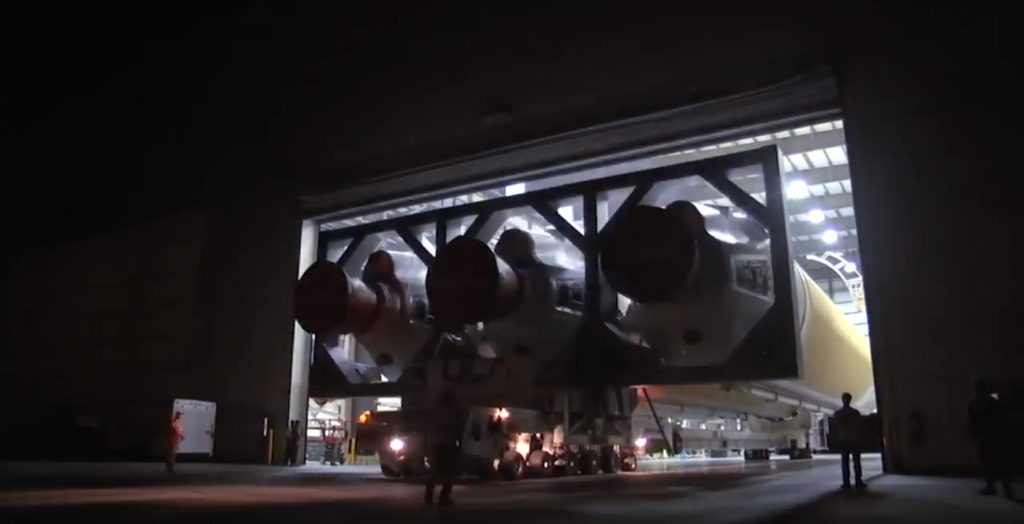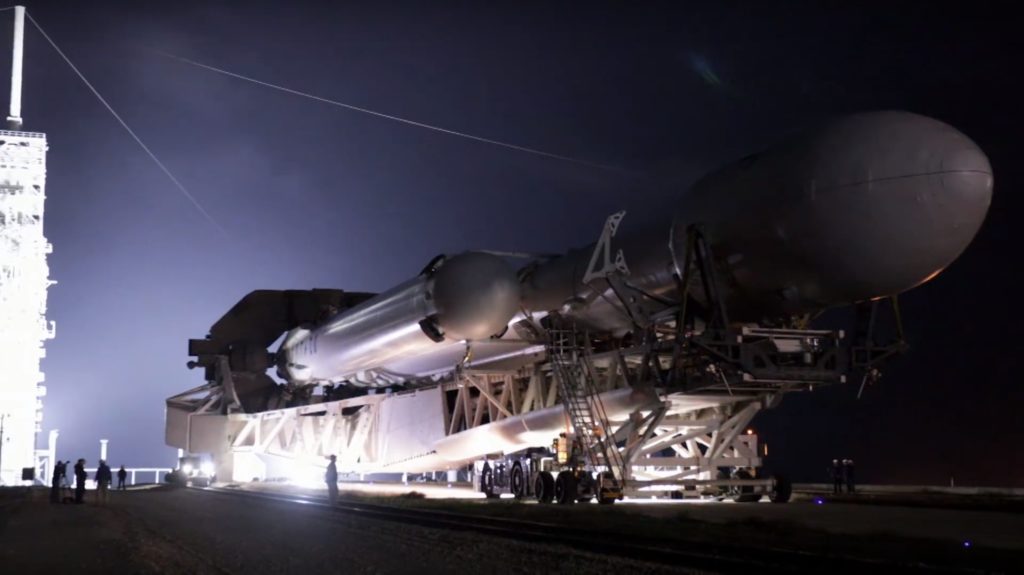

News
How SpaceX Falcon Heavy undercuts its competition three-fold
Following the stunningly successful debut of SpaceX’s giant Falcon Heavy rocket, the spaceflight fan community and industry have been abuzz with attempts to estimate Falcon Heavy’s true price as an expendable or partially expendable launch vehicle. Thankfully, CEO Elon Musk appears to have been interested enough to fill in the knowledge gaps concerning the rocket’s full range of prices and took to Twitter to answer several questions.
Among several other intriguing comments that I will cover later on, Musk revealed that a fully expendable Falcon Heavy would cost approximately $150 million, while a partially expendable FH would sport 90% of the performance while expending the center stage and landing the side boosters at sea rather than on land. In that latter mode of operation, a Falcon Heavy launch would cost about $95 million, whereas unlocking the final 10% of performance with a fully expandable configuration would be priced around $150 million. While $90-150 million is undeniably a huge amount of cash in any sense, Falcon Heavy delivers far more performance for multiple times less than the available competition.
- ULA’s Delta IV Heavy rolls out to the pad for a launch in 2016. Note the people in the bottom left for a sense of scale. (ULA)
- ULA’s Delta IV Heavy rolls out to the pad for a launch in 2016. Note the people in the bottom left for a sense of scale. (ULA)
- The fully-integrated Falcon Heavy rolls out to Pad 39A. For vertical integration, think of this… but vertical. (SpaceX)
- DIVH and FH are approximately the same size, although FH is far denser. (SpaceX)
The only real competition for Falcon Heavy is the United Launch Alliance’s (ULA) Delta IV Heavy rocket, a triple-core launch vehicle with nine total launches under its belt since its 2004 debut. Aside from one test launch for NASA, all of DIVH’s operational flights have been tasked with launching uniquely heavy military payloads to uniquely high orbits – both of which require an exceptionally capable rocket. Designed as a fully expendable vehicle, ULA’s Heavy is capable of launching ~29,000 kg to low Earth orbit (LEO) and ~14,000 kg to geostationary transfer orbit (GTO), whereas the fully reusable Falcon Heavy has a max payload of about 23,000 kg to LEO and 8,000 kg to GTO.
However, if Musk’s claim of 10% performance loss as a partially expendable launcher holds true, the story changes quite a bit. In its fully expendable configuration (call it the Delta IV Heavy config), Falcon Heavy is a beast of a rocket, quoted at ~64,000 kg to LEO and 26,700 kg to GTO. Subtract 10-25%, and Falcon Heavy still trounces the Delta rocket, all while costing well under $150 million, and probably closer to $100 million. According to a late-2017 report from the US Government Accountability Office, Delta IV Heavy costs as much as $400 million per launch, although ULA CEO Tory Bruno responded to Musk’s claim of $400-600 million earlier this morning with a figure of $350 million for the rocket.
Hey @elonmusk , congrats again your heavy launch. Clarification: Delta IV Heavy goes for about $350M. That’s current and future, after the retirement of both Delta IV Medium and Delta II. She also brings unique capabilities, At least until we bring Vulcan on line.
— Tory Bruno (@torybruno) February 12, 2018
Such a high price is not exceptionally surprising, if only for the fact that Delta IV Heavy launches as infrequently as it does. With an average cadence of one launch every 18 months or 1.5 years, the technical expertise and facilities required to design, build, and operate the DIVH must remain employed regardless of whether the rocket launches. Although Delta was previously a family of rockets, thus enabling some of its designers and builders to cross-populate, the final non-Heavy Delta launch occurred just a handful of weeks ago. Short of layoffs, this means that ULA’s Delta expertise are now solely working to build and operate a rocket with approximately seven launches scheduled between 2018 and 2023 – in short, $400 million is quite plausibly on the low end of the rocket’s actual cost, backend included. Both ULA and the Department of Defense are aware, however, that Delta IV Heavy is the only rocket currently capable of launching some of the missions desired and required by the National Reconnaissance Office (NRO), and are thus at least partially willing to swallow the vehicle’s high cost. SpaceX’s Falcon Heavy is bound to introduce some much-needed competition into the stagnant market after its highly successful introduction, but it will likely be a year or more before the new rocket is certified to launch the same highly sensitive and expensive payloads as ULA’s Delta IV Heavy.
How are SpaceX’s prices so low?
Still, this does not answer the “how” of SpaceX’s prices. What can even begin to explain Delta IV Heavy’s 200-400% premium over Falcon Heavy? The best answer to this crucial question was by no coincidence also one of the main reasons that Elon Musk created SpaceX. From the very beginning, SpaceX pursued a slim and flexible organizational structure, prioritized hiring brilliant and motivated engineers with hands-on experience, and encouraged the practice of thinking from first principles. Dolly Singh, head of SpaceX’s talent acquisition in the mid-2000s, described the rocket startup’s atmosphere like so:
We searched for candidates with a proven history of building and breaking things…candidates who had been tinkering with hardware systems for years…I knew the people who filled my open positions would be put to the test every day and would be asked to meet heretofore impossible targets. We looked for people with a history of defeating the odds, who had made careers of overcoming obstacles.
https://www.instagram.com/p/BVarZZSgfIP/
Birds of an organizational feather
In essence, this organizational philosophy has led SpaceX to become vertically integrated to the extent that is effective without comparison in the global aerospace industry. Vertical integration is a term used to describe the practice of bringing aspects of development and manufacturing in-house, whereas a company not attempting to integrate vertically would instead contract and subcontract out their design and manufacturing needs wherever possible. Musk is hard set on this philosophy: if SpaceX can do it in-house more cheaply than a contractor, they will become their own supplier. Companies like ULA – a cooperation between Lockheed Martin and Boeing – have the better part of a century of experience as heavyweights in the US military-industrial complex, a relationship that has quite literally changed processes of acquisition and created alternate realities of pricing.
Thick with armies of lobbyists, those military-industrial complex titans have help to direct the US down a path that has solidified truly insane concepts as the status quo. A cost-plus contracting framework almost universally applied in the procurement of military technology means that companies are nearly awarded for delays and cost overruns. Possibly even more absurd, the euphemistic strategy of “concurrency” espoused by those same titans has somehow convinced the upper echelons of US defense procurement that it is a good and preferable strategy to fully fund and build technologies en mass before any testing has been. Unsurprisingly, these two philosophies have led to years of delays and huge cost overruns as contractors and their subcontractors are forced to repair or modify extremely complex technological systems once bugs and problems are inevitably discovered down the road. The F-35 Lightning II – developed by Lockheed Martin – is perhaps the most famous example with near-weekly tales of abject failure – gun systems that are years late and inaccurate to the point of uselessness, extremely buggy and flawed software that the jet literally cannot function without, an oxygen system that frequently gives its pilots hypoxia and grounds the entire F-35 fleet, among dozens of other incredible missteps – and all for the most expensive fighter aircraft yet developed in the US. Tyler Rogoway, one of the best practicing defense journalists, has covered the debacle of concurrency and cost-plus contracting for many years and is a recommended read for anyone interested in the above industries.
- While it may look damn cool, the F-35 is easily the biggest government procurement debacle in all of human history. (Lockheed Martin)
- Operated by the same company responsible for the F-35, Atlas 5 is a highly reliable and equally expensive rocket. (ULA)
Now, back to spaceflight…
Parting from this partial diversion, the purpose of this brief history of military procurement is to provide some level of context as to why NASA and its spaceflight contractors act as they do, where they derived their organizational structures and philosophies, and why SpaceX is different.
Famously, a NASA study in 2010 estimated the cost of SpaceX’s Falcon 9 development to be approximately $4 billion under variables representative of NASA’s own R&D and engineering culture, or $1.7 billion using a more commercial, fixed-cost strategy. When SpaceX offered to cooperate with the addition of their internal data on Falcon 9’s cost, the same model’s estimate plummeted to less than $600 million, representing a truly extraordinary overestimate of SpaceX’s development costs, while SpaceX’s data showed approximately $300 million of investment in the first version of Falcon 9. Simply put, NASA’s cost estimates were off by more than an order of magnitude (PDF) – SpaceX successfully developed an unprecedented orbital-class rocket for mere pennies to NASA’s dollar.
Famously, a NASA study in 2010 estimated the cost of SpaceX’s Falcon 9 development to be approximately $4 billion, while SpaceX’s own data showed approximately $300 million of investment in the first version of Falcon 9. Simply put, NASA’s cost estimates were off by more than an order of magnitude.
More recently, Elon Musk has stated that SpaceX invested $1 billion or more in the development of reusability for Falcon 9, and this large investment can almost entirely explain why Falcon 9’s pricing has remained essentially unchanged over its seven years of life, even if it was already the cheapest rocket in its performance class. Despite the recent introduction and rapid routinization of operational reuse, SpaceX has not publicly changed the launch price from its $62 million base. Although there have been slight acknowledgments of small discounts from customers flying on reused boosters, the general theme is that reused rockets have not meaningfully lowered the cost of purchasing a launch. In practice, the cost of refurbishment and reuse of the first several Falcon 9 boosters was likely on par with the cost of a new booster, but the real reason for the lack of magnitudes of cost reduction lies in SpaceX’s desire to recoup some or all of the capital it invested in reusability. As the company matures its reuse expertise, the cost can be expected to plummet – Cargo Dragon’s reuse, for example, reportedly saved SpaceX 50% of the cost of a new capsule, and Falcon 9 is almost certainly far easier and thus cheaper to refurbish and refly.
The quote is from a 2015 hearing held by the Armed Services Committee: "I don't know how to build a $400 million rocket. Rather than ask how am I less expensive than ULA, I don't understand how ULA is as expensive as they are."
— Robin Seemangal (@nova_road) February 12, 2018
While payload fairings have turned out to be harder to recover than anticipated and Falcon 9’s second stage is likely to remain expendable for the foreseeable future, those components only comprise about 30% of the rocket’s price. If SpaceX can cut the cost of reuse to maybe 10-20% of the cost of a new booster, the remaining 30-60% of a new launch’s $62 million translates to approximately $20-35 million of profit for each reused launch. If, say, the company aims to fly flight-proven boosters on half of their launches in 2018, that translates into as many as 15 launches and as much as $500 million – or half of the $1 billion investment – recouped in a single year. With the introduction of Falcon 9 Block 5 in a few months, SpaceX will soon be flying an iteration of their workhorse rocket that is far faster, easier, and cost-effective to reuse. Ultimately, depending on how much of their initial investment SpaceX intends to recover, the huge profit margins they can derive from reuse could be redirected to drastic price cuts for the customer. More realistically, the company will likely lower its prices enough to ensure that their launch business is brutally competitive, and thus use those profit margins to begin heavily investing in BFR (Big F. Rocket), BFS (Big F. Spaceship), and the company’s loftier interplanetary goals more generally.
- Starship and a Martian city, circa 2017. (SpaceX)
- SpaceX’s 2017 BFS (now Starship) delivers cargo to a large lunar base. (SpaceX)
In fact, given that SpaceX President Gwynne Shotwell has quite consistently targeted early 2019 for the beginning of prototype BFS testing, SpaceX is probably already putting a significant proportion of their profits into Mars-focused R&D. As 2018 progresses, barring any unseen speed bumps, the funds available to SpaceX are bound to explode, and huge progress will likely begin to be made on actual hardware intended to enable colonies on the Moon and Mars.
Follow along live as launch photographer Tom Cross and I cover these exciting proceedings as close to live as possible.
Teslarati – Instagram – Twitter
Tom Cross – Twitter
Eric Ralph – Twitter

News
Tesla hints at Starlink integration with recent patent
“By employing polymer blends, some examples enable RF transmission from all the modules to satellites and other communication devices both inside and outside the vehicle.”

Tesla hinted at a potential Starlink internet terminal integration within its vehicles in a recent patent, which describes a vehicle roof assembly with integrated radio frequency (RF) transparency.
The patent, which is Pub. No U.S. 2025/0368267 describes a new vehicle roof that is made of RF-transparent polymer materials, allowing and “facilitating clear communication with external devices and satellites.”
Tesla believes that a new vehicle roof design, comprised of different materials than the standard metallic or glass elements used in cars today, would allow the company to integrate modern vehicular technologies, “particularly those requiring radio frequency transmission and reception.
Tesla has recently filed a US patent application on integrating RF transparent materials into the roof structure.
“facilitating clear communication with external devices and satellites”
Tesla fleet is getting @Starlink connectivity integration soon. LFG @Tesla @elonmusk… pic.twitter.com/bLa8YtPLd1
— Chansoo Byeon (@Chansoo) December 9, 2025
Instead of glass or metallic materials, Tesla says vehicles may benefit from high-strength polymer blends, such as Polycarbonate, Acrylonitrile Butadiene Styrene, or Acrylonitrile Styrene Acrylate.
These materials still provide ideal strength metrics for crashworthiness, stiffness for noise, vibration, and harshness control, and are compliant with head impact regulations.
They would also enable better performance with modern technologies, like internet terminals, which need an uninterrupted signal to satellites for maximum reception. Tesla writes in the patent:
“By employing polymer blends, some examples enable RF transmission from all the modules to satellites and other communication devices both inside and outside the vehicle.”

One of the challenges Tesla seems to be aware of with this type of roof design is the fact that it will still have to enable safety and keep that at the forefront of the design. As you can see in the illustration above, Tesla plans to use four layers to increase safety and rigidity, while also combating noise and vibration.
It notes in the patent that disclosed examples still meet the safety requirements outlined in the Federal Motor Vehicle Safety Standards (FMVSS).
Starlink integrated directly into Tesla vehicles would be a considerable advantage for owners. It would come with a handful of distinct advantages.
Initially, the inclusion of Starlink would completely eliminate cellular dead zones, something that is an issue, especially in rural areas. Starlink would provide connectivity in these remote regions and would ensure uninterrupted service during road trips and off-grid adventures.
It could also be a critical addition for Robotaxi, as it is crucial to have solid and reliable connectivity for remote monitoring and fleet management.
Starlink’s growing constellation, thanks to SpaceX’s routine and frequent launch schedule, will provide secure, stable, and reliable internet connectivity for Tesla vehicles.
Although many owners have already mounted Starlink Mini dishes under their glass roofs for a similar experience, it may be integrated directly into Teslas in the coming years, either as an upgrade or a standard feature.
News
Tesla supplements Holiday Update by sneaking in new Full Self-Driving version
It seems Tesla was waiting for the Hardware 4 rollout, as it wanted to also deploy a new Full Self-Driving version to those owners, as it appeared in the release notes for the Holiday Update last night.

Tesla has surprised some owners by sneaking in a new Full Self-Driving version with the wide release of the Holiday Update, which started rolling out to Hardware 4 owners on Friday night.
Tesla has issued a controlled and very slow release pattern with the Holiday Update, which rolls out with Software Version 2025.44.25.5.
For the past two weeks, as it has rolled out to Hardware 3 and older Tesla owners, the company has kept its deployment of the new Software Version relatively controlled.
It seems Tesla was waiting for the Hardware 4 rollout, as it wanted to also deploy a new Full Self-Driving version to those owners, as it appeared in the release notes for the Holiday Update last night.
Tesla Full Self-Driving v14.2.1.25 made its first appearance last night to Hardware 4 owners who are members of the Early Access Program (EAP). It appears to be a slight refinement from FSD v14.2.1, which has been out for a couple of weeks.
Tesla v2025.44.25.5 Holiday update incoming
Also Full Self-Driving v14.2.1.25!!! pic.twitter.com/74D7S0UGXz
— TESLARATI (@Teslarati) December 13, 2025
Many owners welcome the new FSD version, us included, because we’ve been less than impressed with v14.2.1. We have experienced some minor regressions with v14.2.1, especially with Speed Limit recognition, Speed Profile tinkering, and parking performance.
As it stands, Full Self-Driving is still particularly impressive, but Tesla is evidently having an issue with some of the adjustments, as it is still refining some of the performance aspects of the suite. This is expected and normal with some updates, as not all of them are an improvement in all areas; we routinely see some things backtrack every once in a while.
This new FSD version is likely to take care of those things, but it also includes all of the awesome Holiday Update features, which include:
- Grok with Navigation Commands (Beta) – Grok will now add and edit destinations.
- Tesla Photobooth – Take pictures inside your car using the cabin-facing camera
- Dog Mode Live Activity – Check on your four-legged friend on your phone through periodic snapshots taken of the cabin
- Dashcam Viewer Update – Includes new metrics, like steering wheel angle, speed, and more
- Santa Mode – New graphics, trees, and a lock chime
- Light Show Update – Addition of Jingle Rush light show
- Custom Wraps and License Plates – Colorizer now allows you to customize your vehicle even further, with custom patterns, license plates, and tint
- Navigation Improvements – Easier layout and setup
- Supercharger Site Map – Starting at 18 pilot locations, a 3D view of the Supercharger you’re visiting will be available
- Automatic Carpool Lane Routing – Navigation will utilize carpool lanes if enabled
- Phone Left Behind Chime – Your car will now tell you if you left a phone inside
- Charge Limit Per Location – Set a charge limit for each location
- ISS Docking Simulator – New game
- Additional Improvements – Turn off wireless charging pad, Spotify improvements, Rainbow Rave Cave, Lock Sound TRON addition
Tesla also added two other things that were undocumented, like Charging Passport and information on USB drive storage to help with Dashcam.
Cybertruck
Tesla updates Cybertruck owners about key Powershare feature

Tesla is updating Cybertruck owners on its timeline of a massive feature that has yet to ship: Powershare with Powerwall.
Powershare is a bidirectional charging feature exclusive to Cybertruck, which allows the vehicle’s battery to act as a portable power source for homes, appliances, tools, other EVs, and more. It was announced in late 2023 as part of Tesla’s push into vehicle-to-everything energy sharing, and acting as a giant portable charger is the main advantage, as it can provide backup power during outages.
Cybertruck’s Powershare system supports both vehicle-to-load (V2L) and vehicle-to-home (V2H), making it flexible and well-rounded for a variety of applications.
However, even though the feature was promised with Cybertruck, it has yet to be shipped to vehicles. Tesla communicated with owners through email recently regarding Powershare with Powerwall, which essentially has the pickup act as an extended battery.
Powerwall discharge would be prioritized before tapping into the truck’s larger pack.
However, Tesla is still working on getting the feature out to owners, an email said:
“We’re writing to let you know that the Powershare with Powerwall feature is still in development and is now scheduled for release in mid-2026.
This new release date gives us additional time to design and test this feature, ensuring its ability to communicate and optimize energy sharing between your vehicle and many configurations and generations of Powerwall. We are also using this time to develop additional Powershare features that will help us continue to accelerate the world’s transition to sustainable energy.”
Owners have expressed some real disappointment in Tesla’s continuous delays in releasing the feature, as it was expected to be released by late 2024, but now has been pushed back several times to mid-2026, according to the email.
Foundation Series Cybertruck buyers paid extra, expecting the feature to be rolled out with their vehicle upon pickup.
Cybertruck’s Lead Engineer, Wes Morrill, even commented on the holdup:
As a Cybertruck owner who also has Powerwall, I empathize with the disappointed comments.
To their credit, the team has delivered powershare functionality to Cybertruck customers who otherwise have no backup with development of the powershare gateway. As well as those with solar…
— Wes (@wmorrill3) December 12, 2025
He said that “it turned out to be much harder than anticipated to make powershare work seamlessly with existing Powerwalls through existing wall connectors. Two grid-forming devices need to negotiate who will form and who will follow, depending on the state of charge of each, and they need to do this without a network and through multiple generations of hardware, and test and validate this process through rigorous certifications to ensure grid safety.”
It’s nice to see the transparency, but it is justified for some Cybertruck owners to feel like they’ve been bait-and-switched.
















